2580
Views & Citations1580
Likes & Shares
Schizophrenia is psychiatric disorders that are affect the thinking, behaves, emotions etc. of the patients. The symptoms of schizophrenia are commonly observed at the age of 16-30. The symptoms of schizophrenia are divided into three types: Positive, Negative & Cognitive symptoms [6]. Antipsychotics medications are principally used in treatment of schizophrenia & other psychotic disorders such as mental sickness, bipolar disorder, etc. Antipsychotic medications are classified into two major classes Typical & Atypical it’s also called first- & second-generation drugs [7]. Antipsychotic drugs are taking around 7-14 days to reach their desire therapeutic effect. Antipsychotics unable to treat negative symptoms & able to treat / cure positive symptoms of schizophrenia. Atypical antipsychotics shows/ possess negative symptoms such as incapable to feel pleasure (Anhedonia), Alogia, Flattening, Apathy, Avolition etc. [2].
SYMPTOMS OF SCHIZOPHRENIA
The psychological symptoms of schizophrenia are divided into three main classes: Positive, Negative & Cognitive Symptoms. While Positive & Cognitive Symptoms are almost omnipresent in schizophrenia, Positive symptoms have unrelated with cognitive symptoms. However, this relationship appeared to be accompanied by negative symptoms [8].
- Positive Symptoms:
Positive symptoms are related with the hyperdopaminergic transmission occurring in the mesolimbic region of brain. Dopamine Receptor Antagonist drugs such as Chlorpromazine & Haloperidol are used to reduce the positive symptoms of schizophrenia [9]. It is associated with psychological behavior that is not widespread in an enthusiastic person. Suffering people may lose a touch of truth. Following some symptoms include such as delusions, hallucination, dysfunctional way of intellectual, agitated body movement, thought disorder & lack of speaking etc. [6,9].
- Negative Symptoms:
A negative symptom indicates the abnormal normal mental function involving thoughts, behaviors & perceptions [10]. From these interruptions they can vary in general feelings and behaviors. The flat effect that the expression of emotions is reduced by facial expressions or tone of voice. Difficultly in initiating and sustaining activity and mutism (Speak Disorder) [9]. In Negative Symptoms you might notice: Anhedonia, Alogia, Flattening, Apathy, Avolition etc. [10].
- Cognitive Symptoms:
The cognitive symptoms of schizophrenia are belongs to thinking of persons. Although cognitive symptoms aren’t used to detect schizophrenia [11]. These symptoms can vary from person to person [12]. Victims may experience normal to serious changes in their intelligence or in any other aspect of thought. Symptoms may include difficulty concentrating; memory problem, lack of execution facilities, i.e. difficulty in understanding information & making decisions [5]. In it seen some symptoms such as unable to concentrate, memory problems, reduced executive function, lack of insight etc. [11].
Causes
An exact cause of Schizophrenia is unknown. Researchers are continuously trying to find about the etiology of the disease [13] but abnormal brain structure, enter-changes in neurotransmitter functioning, genetic & environmental factors cause schizophrenia [11].
Risk Factor (Figure 1)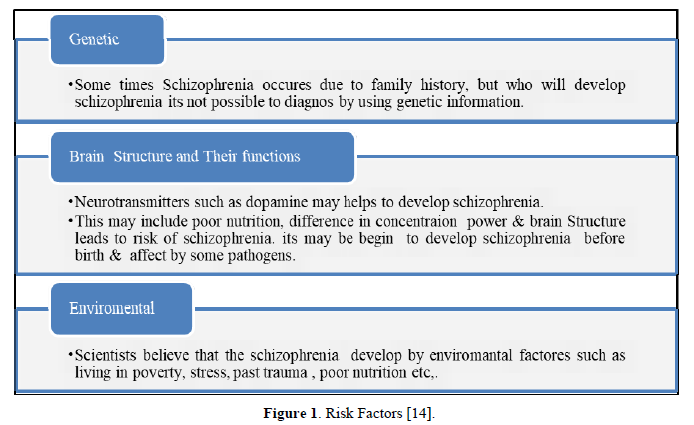
ANTIPSYCHOTIC
Antipsychotic is a drug which are used to treat symptoms of psychosis. They are also used to treat Schizophrenia, Depression, Bipolar disorder, Schizo affective disorders & Anxiety. Antipsychotics drugs shows adverse effect [15].
Classification of Antipsychotic Drugs
Antipsychotic drugs are classified into two subtypes such as Typical (First generation) & Atypical (Second generation). Typical medications have been used since the 1950s. It’s oldest or first type of antipsychotic drugs or medicines. Atypical medications have been used since the 1990s. It’s new or second type of antipsychotic class of drugs [16]. The use of antipsychotic drugs has the benefit of reducing the symptoms of psychosis and the risk of numerous side effects, including a difficult trade-off. Antipsychotic drugs are not therapeutic & do not eliminates long term thought disorders but they often negate the power of illusion, delusions & allow a person with schizophrenia to act in a caring situation (Figure 2) [13].
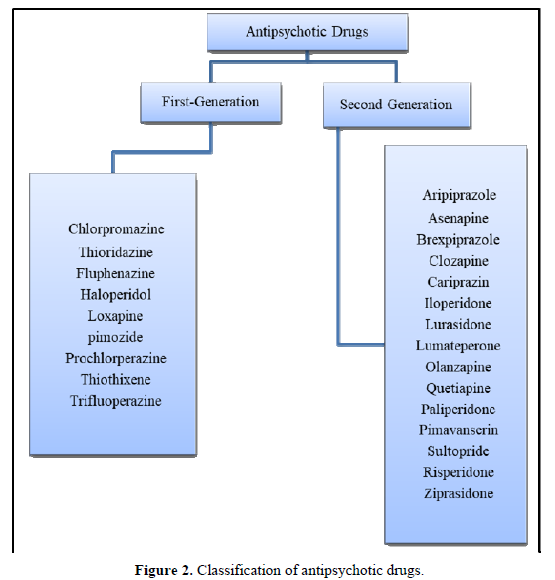
Antipsychotic medicine is a principle psychological strategy for the treatment of schizophrenia. These substances limit the effectiveness of treatment in individual patients & are associated with side effects. Taking antipsychotics is considered. While these drugs have no effect on negative symptoms. All of these drugs stop the action of postsynaptic dopamine D2 receptors. However, modern medicine has a wide spectrum of targeted Serotonin, nor epinephrine, Acetylcholine, Histamine & Glutamate. Clozapine, considered an atypical antipsychotic, is associated with a variety of neuroreceptors (Dopamine, 5-HT serotonin & noradrenergic receptor) & and some acts as a multi-neuroreceptor antagonist. Clozapine is the most potent or highly effective antipsychotic drug & it’s does also reduce the risk of suicide of schizoaffective patients who tolerate to other antipsychotic drugs [2].
Mechanism of Action
There are many drugs used to treat schizophrenia & they have different mechanism of action to create desired therapeutic effects. Mostly antipsychotics drugs help to treat Schizophrenia [17].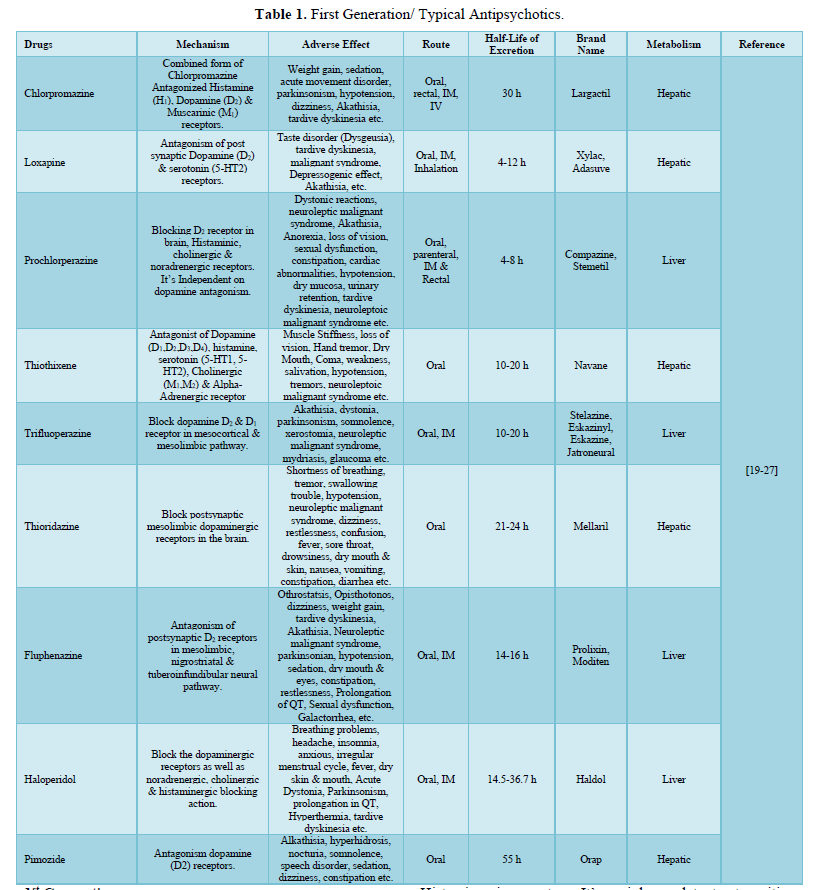
1st Generation
The first generation of antipsychotics follows inhibiting mechanism. They are highly effective when they block 72% of the D2 dopamine receptors in the brain. They also show antagonism action at the Noradrenergic, Cholinergic & Histaminergic receptors. It’s mainly used to treat positive symptoms such as hallucinations & delusions [7,18]. In Typical antipsychotics show some adverse effect such extra-pyramidal side effects & anticholinergic adverse effect such as dry mouth, constipation etc. sedation, abnormal heart rates, sudden death, seizure threshold, hypotension, discoloration of skin, hydration, confusion, fever, acute renal failure etc. as well it’s have some contraindications like CNS depressant, cardiac abnormalities, history of allergy & seizure disorders, prostatic hypertrophy, dyskinesia, etc. [7].
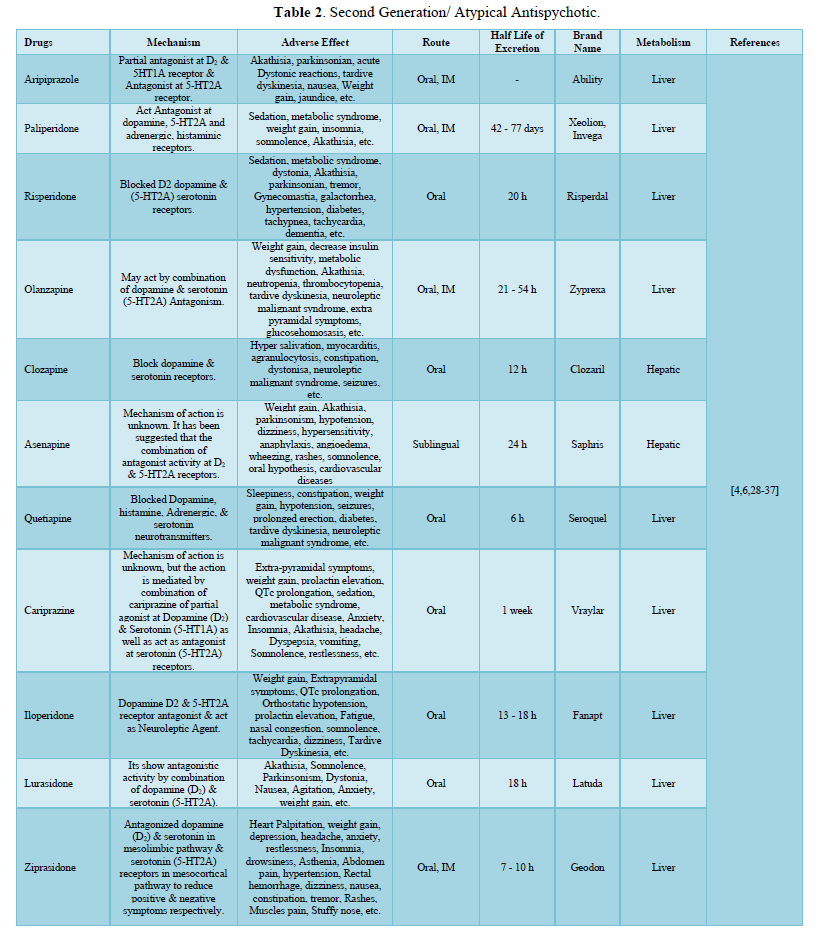
2nd Generation
The second generation of antipsychotics follows blocking mechanism. Its block the D2 dopamine receptors as well as serotonin receptors antagonist. 5-HT2A sub-type of the serotonin receptor is most commonly involved, thus may be associated with reduced risk of these adverse effect. In 2016, 12 Atypical Antipsychotics are approved by Food & Drug Administration (FDA) [7,18]. In Atypical antipsychotics show some side effects such as weight gain, metabolic syndrome development, dizziness, anxiety, sedation, thermo-sensitive, increased appetite, somnolence, hypotension, agitation, headache, restlessness, hyper salivation, etc. and it have some contraindications like parkinsonism, narcoleptic, tardive dyskinesia, during pregnancy, glaucoma, liver disease, severe neutropenia, deficiency hexosaminidase etc. [7].
TREATMENT
Antipsychotic Drugs
Physician recommended a combination of psychotic drugs along with the psychotherapy (Tables 1 & 2).
Ayurvedic Treatment
Brahmyadiyoga is an herbal preparation which is used in the treatment of Schizophrenia. Brahmyadiyoga developed by Central Council for Ayurveda & Siddha, under Ministry of Health & Family Welfare of India. It includes Brahmi, Jatamansi, Sarpagandha, Vacha, Kusta, Tagar etc. For the treatment of schizophrenia, herbal combination of water-based extract of bramhi & Jatamansi are as effective as modern antipsychotics drugs (Table 3) [6].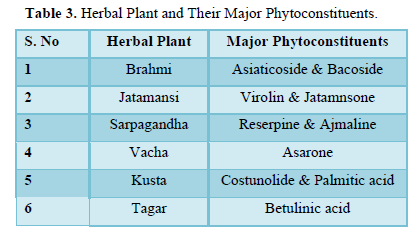
CONCLUSION
We concluded from this review article; schizophrenia is a complex psychiatric disorder that is belong to the disordering of brain improvement caused by environmental as well as some genetic factors. Most schizophrenia as well as psychotic disorders occurs due to abnormal brain structure & functioning. In this article we discuss about pharmacology of antipsychotics & Ayurvedic Treatment of psychosis. In that we observe delusion, hallucination, speech & behavior disorder like symptoms. In this we know about pharmacology of antipsychotics drugs but their exact causes of schizophrenia are unknown, I hope in future our researches are find exact causes of schizophrenia.
-
Patel KR, Cherian J, Gohil K, Atkinson D (2014) Schizophrenia: Overview and Treatment Options. P T 39(9): 638-645.
-
Farah FH (2018) Schizohrenia: An Overview. Asian J Pharm 12(2): 77-87.
-
WHO (2019) Schizophrenia. Available online at: https://www.who.int/news-room/fact-sheets/detail/schizophrenia
-
Bouchette D, Fariba AK, Marwaha R (2021) Ziprasidone. Treasure Island (FL): StatPearls Publishing. Available online at: https://www.ncbi.nlm.nih.gov/books/NBK448157/#!po=68.5185
-
Peter H, Kirk R, Green R (2016) Chlopromazine, the first antipsychotic medication: history, controversy and legacy. Br Assoc Psychopharmacol. Available online at: https://www.bap.org.uk/articles/chlorpromazine-the-first-antipsychotic/
-
Ashish C, Mittal A, Arora PK (2013) Atypical Antipsychotics from Scratch to the Present. Int J Pharm Sci Res 4(1): 184-204.
-
Chokhawala K, Stevens L (2021) Antipsychotic Medications. StarPearls Publishing, Treasure Island (FL). Available online at: https://www.ncbi.nlm.nih.gov/books/NBK51950/#_article-17709_s3_
-
Khan ZU, Martin-Montanze E, Muly EC (2013) Schizophrenia: Causes and Treatments. Curr Pharm Design 19(36): 6451-6461.
-
Nerkar AG, Bhise SB (2020) Polypharmacological Drugs in Treatment of Schizophrenia. Curr Trend Pharm Pharm Chem 2(3): 116-124.
-
D'Arrigo T (2020) What Are the Symptoms of Schizophrenia? Available online at: https://www.webmd.com/schizophrenia/schizophrenia-symptoms
-
Clarke J (2022) How Schizophrenia is diagnosed by Observing Symptoms. Available online at: https://www.verywellmind.com/what-are-the-symptoms-of-schizophrenia-2953120
-
Peter C (2019) Psychological debriefing - are we doing more harm than good? Available online at: https://www.blueline.ca/psychological-debriefing-are-we-doing-more-harm-than-good-6321/
-
Harvey RA, Clark MA, Finkel R, Rey JAPD, Whalen K (2011) Lippincott's Illustrated Reviews: Pharmacology. 5th New York: WoltersKluwer.
-
National Institute of Mental Health. Schizophrenia (2020) Schizophrenia. Available online at: https://www.nimh.nih.gov/health/topics/schizophrenia
-
com (2021) Antipsychotics. Available online at: https://www.drugs.com/drugs-class/antipsychotics.html
-
Rethink Mental Illness (2022) Antipsychotics - What you need to know. Available online at: https://www.rethink.org/advice-and-information/living-with-mental-illness/medications/antipsychotics/
-
Kaur H, Kaur R, Rani V, Sharma K, Maurya PK (2020) Antipsychotic Drugs. Available online at: https://www.taylorfrancis.com/chapters/edit/10.1201/9780429242717-15/antipsychotic-drugs-harleen-kaur-ramneek-kaur-varsha-rani-kanishka-sharma-pawan-kumar-maurya
-
NeuRa (2021) First versus second generation. Available online at: https://www.library.neura.edu.au/schizophrenia/treatment/physical/pharmaceutical/second-generation-antipsychotics/first-versus-second-generation/
-
Cardoso D, Wakeham J, Shaw PA, Brittany D, Wildman L (2017) Chlorpromazine verses thiothixene for people with schizophrenia. Cochrane Database Syst Rev 2017(9): 1-17.
-
Mann SK, Marwaha R (2021) Chlorpromazine. Treasure Island (FL): StatPearls Publishing. Available online at: https://www.ncbi.nlm.nih.gov/books/NBK553079/
-
Dina P, Nuss P, Vieta E (2015) Revisiting loxapine: A systematic review. Ann Gen Psychiatry 14(15): 1-8.
-
Lennox D, Preuss CV (2021) Prochlorperazine. Treasure Island (FL): StatPearls Publishing. Available online at: https://www.ncbi.nlm.nih.gov/books/NBK537083#!po=91.9355
-
Wikipedia (2022) Trifluoperazine. Available online at: https://en.m.wikipedia.org/wiki/Trifluoperazine
-
NIH (2021) Inxight Drugs. Available online at: https://drugs.ncats.io/drug/4WCI67NK8M
-
Siragusa S, Bistas KG, Saadabadi A (2021) Fluphenazine. Treasure Island (FL): StatPearls Publishing. Available online at: https://www.ncbi.nlm.nih.gov/books/NBK459194/
-
Rahman S, Marwaha R (2022) Haloperidol. Tresaure Island (FL): StatPearls Publishing. Available online at: https://www.ncbi.nlm.nih.gov/books/NBK560892/#_NBK560892_pubdet_
-
WebMD (2018) Pimozide Oral: Uses, Side Effects, Interactions, Pictures, Warnings & Dosing. Available online at: https://www.webmd.com/drugs/2/drug-11062/pimozide-oral/details
-
Gettu N, Saadabadi A (2021) Aripiprazole. Ed. Abdolreza Saadabadi. Treasure Island (FL): StatPearls Publishing. Available online at: https://www.ncbi.nlm.nih.gov/books/NBK547739
-
Zhang LL, Li JT, Zhao YJ, Su YA, Si T (2016) Critical evaluation of paliperidone in the treatment of schizophrenia in Chinese patients: A systematic literature review. Neuropsychiatr Dis Treat 12: 113-131.
-
McNeil SE, Gibbons JR, Cogburn M (2021) Risperidone. Treasure Island (FL): StatPearls Publishing. Available online at: https://www.ncbi.nlm.nih.gov/books/NBK459313/#_NBK459313_pubdet_
-
Krishna T, Saadabadi A (2021) Olanzapine. Treasure Island (FL): StatPearls Publishing. Available online at: https://www.ncbi.nlm.nih.gov/books/NBK532903/
-
Physiopedia (2022) Clozapine in the Treatment of Psychosis. Ed. Jordan Rodrigues and Mieka Bryan. n.d. Available online at: https://www.physio-pedia.com/Clozapine_in_the_Treatment_of_Psychosis
-
Steven G, Potkin J (2011) Asenapine: A Clinical Overview. J Clin Psychiatry 72: 14-18.
-
Maan JS, Ershadi M, Khan I, Saadabadi A (2021) Quetiapine. Treasure Island (FL): StatPearls Publication. Available online at: https://www.ncbi.nlm.nih.gov/books/NBK459145/#_NBK459145_pubdet_
-
Laszlovszky I, Barabassy A, Nemeth G (2021) Cariprazine, a Broad-Spectrum Antipsychotic for the Treatment of Schizophrenia: Pharmacology, Efficacy, and Safety. Adv Ther 38(7): 3652-3673.
-
Citrome L (2011) Iloperidone: A Clinical Overview. J Clin Psychiatry 72: 19-23.
-
Kane JM (2011) Lurasidone: A Clinical Overview. J Clin Psychiatry 72: 24-28.



